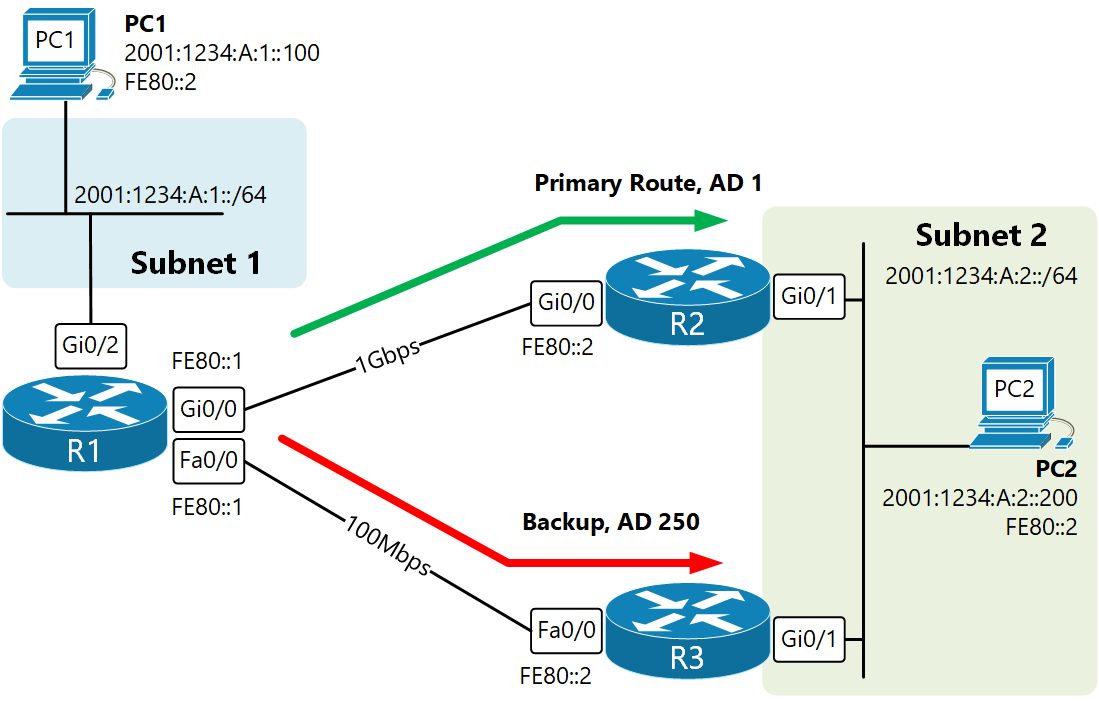
Table of Contents
IP routing is the process of moving packets across a network from a source to a destination. It involves various protocols and techniques to ensure efficient and reliable data transmission. Chapter 5 of the "CCIE Routing and Switching v5.0 Official Cert Guide, Volume 1" offers a comprehensive exploration of IP routing. This blog post will introduce key technical terms and fundamental concepts of IP routing, enabling readers to understand how data navigates through complex network infrastructures.
What is IP Routing?
IP routing is the mechanism by which data packets are forwarded from one network segment to another. It involves routers and routing protocols that determine the best path for data to travel across an interconnected network. Routers maintain routing tables that store the routes to different network destinations.
Key Components of IP Routing:
- Routing Table: A database in a router that stores route information, including destination networks and the next hop to reach them.
- Routing Protocols: Algorithms and processes that routers use to communicate route information and select optimal paths.
- Next Hop: The immediate next device to which a packet should be forwarded on its way to the final destination.
Static vs. Dynamic Routing
Routing can be classified into static and dynamic routing based on how routes are determined and maintained.
Static Routing:
- Definition: Static routing involves manually configuring routes in a router's routing table.
- Use Cases: Typically used in smaller networks or specific network segments where routes do not change frequently.
- Advantages: Simple and predictable.
- Disadvantages: Lack of scalability and flexibility, as manual updates are required for changes.
Dynamic Routing:
- Definition: Dynamic routing uses routing protocols to automatically discover and maintain routes.
- Use Cases: Suitable for larger, complex networks with frequent topology changes.
- Advantages: Scalability, flexibility, and adaptability.
- Disadvantages: Requires more resources and introduces complexity.
Common Routing Protocols
Routing protocols are essential for dynamic routing, enabling routers to exchange information and determine the best paths for data packets. Here are some key routing protocols:
RIP (Routing Information Protocol):
- Type: Distance-vector routing protocol.
- Metric: Hop count.
- Characteristics: Simple to configure, suitable for small networks, limited to 15 hops, updates every 30 seconds.
OSPF (Open Shortest Path First):
- Type: Link-state routing protocol.
- Metric: Cost, based on bandwidth.
- Characteristics: Scalable, fast convergence, hierarchical design with areas, supports VLSM and CIDR.
EIGRP (Enhanced Interior Gateway Routing Protocol):
- Type: Advanced distance-vector protocol.
- Metric: Composite metric (bandwidth, delay, load, reliability).
- Characteristics: Rapid convergence, supports unequal-cost load balancing, uses DUAL algorithm.
BGP (Border Gateway Protocol):
- Type: Path-vector protocol.
- Metric: Path attributes (AS path, next hop, etc.).
- Characteristics: Used for routing between autonomous systems (inter-domain routing), highly scalable, supports policy-based routing.
Route Redistribution
Route redistribution involves sharing route information between different routing protocols within the same network. This process is crucial in networks that use multiple routing protocols, enabling seamless communication across different network segments.
Key Concepts:
- Administrative Distance: A value that routers use to rate the trustworthiness of routes received from different routing protocols. Lower values are preferred.
- Redistribution Process: Configured on a router to import and export routes between different routing protocols.
Routing Metrics and Path Selection
Routing metrics are values used by routing protocols to determine the best path for data packets. Different protocols use different metrics, such as hop count, bandwidth, delay, load, and reliability. Path selection is based on these metrics to optimize network performance.
Common Metrics:
- Hop Count: The number of routers a packet must pass through.
- Bandwidth: The data capacity of a link.
- Delay: The time taken for a packet to traverse a path.
- Load: The amount of traffic on a link.
- Reliability: The likelihood of a link failure.
Route Summarization
Route summarization, or route aggregation, is the process of combining multiple network routes into a single, summarized route. This technique reduces the size of routing tables, conserves bandwidth, and improves network efficiency.
Benefits:
- Reduces Routing Table Size: Aggregates multiple routes, decreasing the amount of routing information that needs to be processed and stored.
- Enhances Performance: Simplifies routing decisions, reducing the processing load on routers.
- Improves Stability: Minimizes the impact of network changes on routing tables.
Example: If a router has routes to 192.168.1.0/24, 192.168.2.0/24, and 192.168.3.0/24, it can summarize them as 192.168.0.0/22.
IPv6 Routing
IPv6 routing introduces new considerations due to the differences between IPv4 and IPv6 addressing. Routing protocols have been updated or developed to support IPv6.
Key Points:
- IPv6 Addressing: Uses 128-bit addresses, vastly increasing the address space compared to IPv4.
- Updated Protocols: OSPFv3, EIGRP for IPv6, and MP-BGP support IPv6 routing.
- Dual Stack: Networks can run IPv4 and IPv6 simultaneously, requiring routers to handle both types of addresses and protocols.
Routing Security
Securing the routing infrastructure is critical to protect against threats such as route hijacking, spoofing, and denial of service attacks. Several techniques and protocols are used to enhance routing security.
Key Security Measures:
- Route Authentication: Ensures that routing updates come from trusted sources. Examples include MD5 authentication for OSPF and BGP.
- Route Filtering: Controls which routes are accepted or advertised, preventing the propagation of invalid or malicious routes.
- Access Control Lists (ACLs): Restrict access to routing protocol communications based on IP addresses and other criteria.
IP routing is a fundamental aspect of network design and operation, ensuring that data packets are efficiently and reliably delivered across interconnected networks. Understanding the principles of static and dynamic routing, routing protocols, route redistribution, metrics, summarization, IPv6 routing, and routing security is essential for network engineers and administrators. Mastery of these concepts enables the design and maintenance of robust, scalable, and secure networks, capable of supporting diverse and evolving communication needs.










